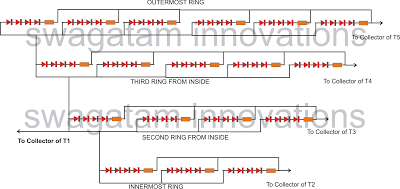
AUDIBLE LIGHT METER

A low light condition on a cadmium sulfide photocell (Radio Shack 276-116) generates a series of clicks in a miniature 8-ohm loudspeaker. As the light intensity increases, these clicks coalesce into an audio tone that escalates in frequency with rising light levels. This circuit can be utilized for classroom demonstrations or as a sunrise alarm clock. The circuit remains silent in complete darkness.
The circuit employs a cadmium sulfide photocell as a light-sensitive component, which exhibits a change in resistance based on the ambient light level. When exposed to low light, the photocell allows a small current to flow, which is then amplified to produce audible clicks in the connected 8-ohm loudspeaker. The sound is generated by rapidly switching the current on and off, creating a clicking effect that can be perceived as a series of pulses.
As the light intensity increases, the resistance of the photocell decreases, allowing more current to flow through the circuit. This change not only increases the loudness of the clicks but also alters the frequency of the sound produced. The circuit can be designed to modulate the frequency of the output tone based on the resistance readings of the photocell, effectively translating light intensity into sound frequency.
For practical applications, this circuit can serve as an educational tool to demonstrate the relationship between light and sound, making it suitable for classroom settings. Additionally, it can function as a sunrise alarm clock by gradually increasing the sound frequency as the ambient light increases, gently waking the user. The design ensures that the circuit remains inactive and silent in complete darkness, conserving power and avoiding unnecessary sound output.
Overall, this circuit exemplifies a simple yet effective method of using a photocell to control audio output, showcasing the principles of light detection and sound generation in a compact electronic design.Low light on cadmium sulfide photocell (Radio Shack 276-116) produces series of clicks in miniature 8-ohm loudspeaker. As light increases, clicks merge into audio tone that increases in frequency as light intensity increases.
Can be used for classroom demonstrations or as sunrise alarm clock. Circuit is quiet in total darkness. -F. M. Mims, "Optoel ectronic Projects, Vol. 1, " Radio Shack, Fort Worth, TX, 1977, 2nd Ed. , p 61-66. 🔗 External reference
The circuit employs a cadmium sulfide photocell as a light-sensitive component, which exhibits a change in resistance based on the ambient light level. When exposed to low light, the photocell allows a small current to flow, which is then amplified to produce audible clicks in the connected 8-ohm loudspeaker. The sound is generated by rapidly switching the current on and off, creating a clicking effect that can be perceived as a series of pulses.
As the light intensity increases, the resistance of the photocell decreases, allowing more current to flow through the circuit. This change not only increases the loudness of the clicks but also alters the frequency of the sound produced. The circuit can be designed to modulate the frequency of the output tone based on the resistance readings of the photocell, effectively translating light intensity into sound frequency.
For practical applications, this circuit can serve as an educational tool to demonstrate the relationship between light and sound, making it suitable for classroom settings. Additionally, it can function as a sunrise alarm clock by gradually increasing the sound frequency as the ambient light increases, gently waking the user. The design ensures that the circuit remains inactive and silent in complete darkness, conserving power and avoiding unnecessary sound output.
Overall, this circuit exemplifies a simple yet effective method of using a photocell to control audio output, showcasing the principles of light detection and sound generation in a compact electronic design.Low light on cadmium sulfide photocell (Radio Shack 276-116) produces series of clicks in miniature 8-ohm loudspeaker. As light increases, clicks merge into audio tone that increases in frequency as light intensity increases.
Can be used for classroom demonstrations or as sunrise alarm clock. Circuit is quiet in total darkness. -F. M. Mims, "Optoel ectronic Projects, Vol. 1, " Radio Shack, Fort Worth, TX, 1977, 2nd Ed. , p 61-66. 🔗 External reference





